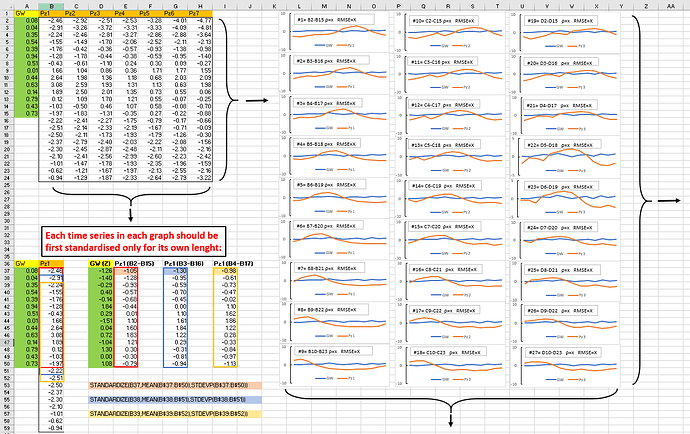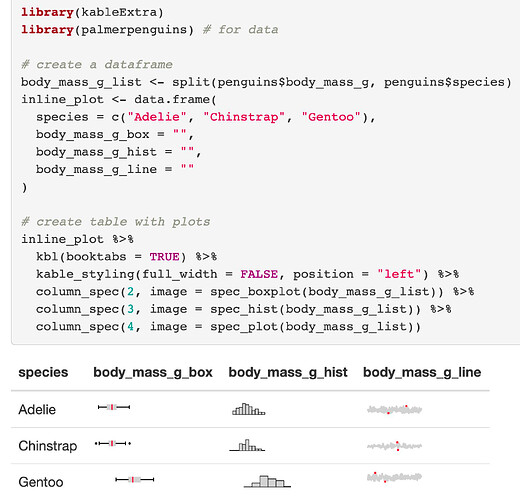Dear all,
I would very much appreciate your help.
Thank you very much and I hope you can help me as I am not really able to do anything like that by myself. If I am asking something that is not appropriate, I am really sorry and I do apologise in advance.
I need to visually inspect a lot of graphs (thousands) for two time series. One of the two is fixed (let's name it GW) and will not change, whilst the others (let's name them Pz1, Pz2, Pz3,...Pz n) will be different for each graph: basically, I need to visually compare GW with all the possible Pz, given a fixed-length (i.e., 10 data points).
The data are in a frame format, i.e.,:
structure(list(GW = c(0.08, 0.04, 0.35, 0.54, 0.39, 0.94, 0.51,
0.01, 0.44, 0.63, 0.14, 0.79, 0.43, 0.73, NA, NA, NA, NA, NA,
NA, NA, NA, NA), Pz1 = c(-2.459826614, -2.905007821, -2.241113224,
-1.549264338, -1.761962438, -1.282612221, -0.428828702, 1.659042479,
2.63518648, 3.076022461, 1.886216859, 0.124473561, -1.025720789,
-1.969461882, -2.216075605, -2.508858567, -2.495831241, -2.36513321,
-2.295002655, -2.103511241, -1.009051105, -0.619616011, -0.941517493
), Pz2 = c(-2.916090168, -3.262459435, -2.455396094, -1.488106654,
-0.417171756, -1.781014095, -0.605012986, 1.037062685, 1.977265974,
2.587846362, 2.499228916, 1.0852274, -0.503736287, -1.829562138,
-2.410220303, -2.135932209, -2.105646454, -2.79131286, -2.446274505,
-2.412041743, -1.467408853, -1.207262381, -1.286558601), Pz3 = c(-2.507944967,
-3.718722989, -2.812847708, -1.702389524, -0.356014073, -0.436223413,
-1.10341486, 0.860878402, 1.355286181, 1.929925855, 2.011052817,
1.698239458, 0.457017552, -1.307577636, -2.270320559, -2.330076907,
-1.732720095, -2.401128073, -2.872454155, -2.563313593, -1.775939355,
-1.665620129, -1.874204971), Pz4 = c(-2.526729696, -3.310577787,
-3.269111262, -2.059841138, -0.570296943, -0.375065729, 0.241375822,
0.362476528, 1.179101897, 1.307946062, 1.35313231, 1.210063358,
1.07002961, -0.346823797, -1.748336058, -2.190177163, -1.926864794,
-2.028201714, -2.482269368, -2.989493243, -1.927211205, -1.974150631,
-2.332562719), Pz5 = c(-3.284551238, -3.329362517, -2.86096606,
-2.516104692, -0.927748557, -0.5893486, 0.302533506, 1.70726721,
0.680700023, 1.131761778, 0.731152517, 0.552142851, 0.58185351,
0.266188261, -0.787582218, -1.668192661, -1.78696505, -2.222346412,
-2.109343009, -2.599308456, -2.353390855, -2.125422481, -2.641093221
), Pz6 = c(-4.011896321, -4.087184059, -2.87975079, -2.107959491,
-1.38401211, -0.946800213, 0.088250636, 1.768424893, 2.025490705,
0.633359905, 0.554968233, -0.069836942, -0.076066996, -0.221987839,
-0.174570161, -0.707438822, -1.264980548, -2.082446669, -2.303487708,
-2.226382097, -1.963206068, -2.551602131, -2.792365071), Pz7 = c(-4.769878994,
-4.814529142, -3.637572331, -2.12674422, -0.975866909, -1.403063767,
-0.269200978, 1.554142023, 2.086648388, 1.978150587, 0.05656636,
-0.246021225, -0.698046789, -0.879908346, -0.66274626, -0.094426764,
-0.304226709, -1.560462167, -2.163587964, -2.420526796, -1.59027971,
-2.161417344, -3.218544722)), class = "data.frame", row.names = c(NA,
-23L))
Basically, I am looking for something that can automatise the entire process and save all the graphs, individually, in a folder so I can patiently check them graphically.
On top of that, both A and B..., should be normalised (Z-Score) before being plotted (i.e., Z=x-mean/Standard deviation), should include some kind of coordinates so I can find them in the matrix (i.e., Graph #4=B5-B8, and ideally (it would be a dream) have also spearman correlation coefficient and RMSE values (please see the image below).
Unfortunately, I have no idea where to start from and your help would be immensely appreciated.
I am sorry if it is confusing and if you need further clarification please, do not hesitate to let me know and I will try to explain it better.
Thank you very much!

